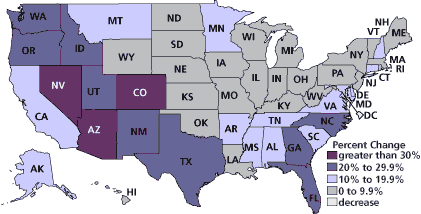
U.S. Population up 13 Percent
(March 2000) The first results from Census 2000 are in, and the U.S. population stands at 281,421,906.
The new total represents an additional 32.7 million Americans (a 13 percent increase) from the 248.7 million Americans counted in the 1990 census. The numerical increase is the largest ever between censuses, and the percentage increase is the largest since the 1970–1980 period.
With 33.9 million people, California remains the largest state; however, Texas has replaced New York as the second largest (20.9 million to 19.0 million). Wyoming, with 493,782 residents, remains the smallest state.
Shifts in Population by State, 1990 to 2000

Source: U.S. Census Bureau.
Only the District of Columbia lost population between 1990 and 2000. California, as one might have expected, had the largest numerical increase at 4.1 million, while Nevada had the highest growth rate at 66 percent.
South, West Gain Seats in House
With the release of the new data, the public also learned how many seats each of the 50 states will get in the House of Representatives during the next decade — effective when the 108th Congress takes office in 2003. As expected, southern and western states will gain seats — mostly at the expense of states in the Northeast and Midwest.
Eight states will gain seats in the new apportionment. Arizona, Florida, Georgia, and Texas will each gain two seats, while California, Colorado, Nevada, and North Carolina will each pick up one seat. The 12 total seats gained by these states will come at the expense of 10 other states. New York and Pennsylvania will lose two seats each, while Connecticut, Illinois, Indiana, Michigan, Mississippi, Ohio, Oklahoma, and Wisconsin will lose one seat each.
The population totals used for the new apportionment include not only the resident population of each state, but also the number of military and civilian employees of the U.S. government (plus their dependents) who are posted overseas. As it turned out, the inclusion of the overseas population made a difference in the final apportionment figures. If only the state resident population totals had been used, North Carolina’s additional seat in the 108th Congress would have gone to Utah. Utah has filed suit against the Census Bureau over its counting method.
Even with the expected gains for the South and West, the new apportionment numbers contained some surprises. Apportionment projections based on 1999 Census Bureau estimates had indicated that Florida and Georgia would each gain only one seat, while Indiana, Michigan, and North Carolina would not be affected by the 2000 apportionment. Those projections also mistakenly predicted that Montana would regain the second House seat that it had lost in the 1990 apportionment.
“An Unusually Strong Count”
In the news conference, Census Bureau director Kenneth Prewitt described the 2000 census as “an unusually strong count” of the U.S. population. In fact, the 281.4 million counted by the census was almost 7 million higher than the Census Bureau had estimated through demographic analysis (274.5 million), a difference greater than the population of Massachusetts. Even if that estimate had been increased to reflect the net undercount in 1990 — bringing the estimated population to 279.2 million — the unadjusted census count is still substantially higher. Prewitt said that the Census Bureau may have been particularly successful in reaching undocumented and temporary workers, a factor he said could account for the high count. Indeed, the 2000 census effort included an aggressive education and outreach program to increase participation of migrant workers and other hard-to-reach groups.
It is also possible that the actual U.S. population is somewhat lower than 281 million. There are two basic types of errors in any census: people who are missed and people who are counted more than once. Results from the post-enumeration survey conducted after the 1990 census indicated that there were 8 million people who were missed and 4 million who were counted on duplicate forms, yielding a net undercount of 4 million people. But if there were more duplicate records than missing ones in 2000, there would be a net overcount, which could account for the surprisingly high total.
To determine the extent of the undercount/overcount in the 2000 census, the Census Bureau is in the process of analyzing results from its Accuracy and Coverage Evaluation Survey. These sample data will be used to determine the accuracy of population totals at the national, state, and local levels, as well as for various subgroups of the population (for example, black children, 7 percent of whom were missed in the 1990 census). In February, the Census Bureau will make a recommendation on whether to release data that have been adjusted.
Kelvin Pollard is a PRB demographer, and Mark Mather is a PRB policy analyst.






